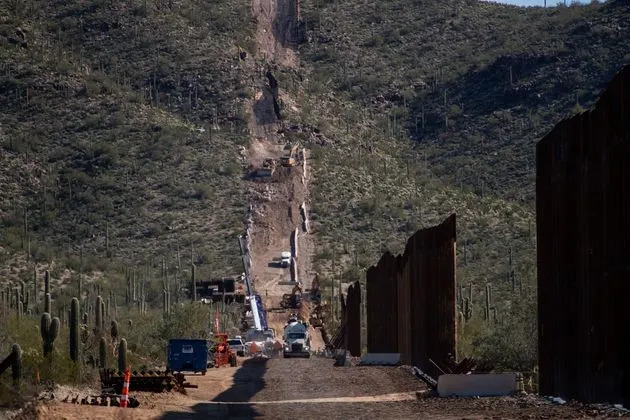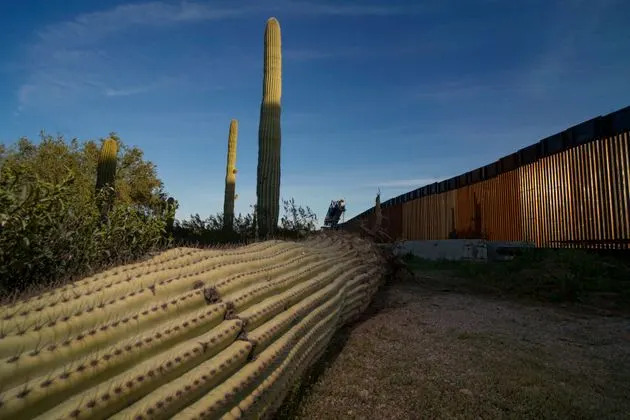Chris D'Angelo
Thu, September 7, 2023
The construction of former President Donald Trump’s wall along the U.S.-Mexico border desecrated Indigenous cultural sites, hurt wildlife, destroyed vegetation, dried up key water resources, exacerbated the risk of flooding and triggered erosion that has left mountain slopes “unstable and at risk of collapse,” according to a new report.
The Government Accountability Office, a nonpartisan government watchdog, reviewed federal data and interviewed government officials, Native American tribes and stakeholders over the course of two years. The result is a comprehensive look at the widespread cultural and environmental harm — much of which experts had predicted — that came from Trump’s relentless pursuit of what he called a “big, beautiful wall” along the southern U.S. border.
The Trump administration spent an estimated $15 billion constructing more than 400 miles of border wall, much of which replaced smaller existing barriers. It waived numerous environmental laws along the way. Trump had insisted during his campaign that Mexico would foot the bill for the construction, but Mexico never paid a dime.
Laiken Jordahl, a conservation advocate at the left-leaning Center for Biological Diversity who documents environmental damage in the borderlands, told HuffPost the report “confirms all our worst fears about the damage wall construction has inflicted” on wildlife, public lands and cultural resources.
Among other things, construction of the wall fragmented wildlife habitats, cut off species’ migration routes and destroyed ancient cacti and other native vegetation.
“These border walls haven’t done a thing to address immigration or smuggling, but they did drive endangered species closer to extinction, butcher thousands of iconic saguaro cacti and dynamite Indigenous sacred sites and burial grounds,” Jordahl said. “This is a clear warning that any attempt to build additional miles of border walls would be a horrifically destructive and useless folly.”
A hill at Coronado National Monument in Hereford, Arizona, was blasted for border wall construction on Sept. 22, 2022.
The federal audit notably follows a federal judge ordering Texas Gov. Greg Abbott (R) on Wednesday to remove floating buoys from the Rio Grande — a barrier that, like Trump’s wall, was meant to deter migrants from crossing the border and that has raised strikingly similar environmental and humanitarian concerns.
Citing information gathered from numerous unidentified federal and tribal officials, the GAO concluded that Trump’s wall negatively impacted cultural and natural resources alike.
“From the start, President Trump’s border wall was nothing more than a symbolic message of hate, aimed at vilifying migrants and bolstering extreme MAGA rhetoric,” Rep. Raúl Grijalva (D-Ariz.), who in 2021 requested the GAO look into the wall’s environmental impacts, said in a statement responding to the report. “This racist political stunt has been an ineffective waste of billions of American taxpayers’ dollars — and now we know it has caused immeasurable, irreparable harm to our environment and cultural heritage as well.”
In Organ Pipe Cactus National Monument, a UNESCO biosphere reserve in southern Arizona that is home to numerous endangered species, contractors bulldozed and blasted land in order to expand an existing patrol road. The work damaged portions of Monument Hill, which is home to cultural and burial sites sacred to the Tohono O’odham and other Native American tribes.
At nearby Quitobaquito Springs, an oasis in the Sonoran Desert that is sacred to the Tohono O’odham people, tribal leaders told the GAO that contractors cleared a large area and destroyed a burial site that the tribal nation had hoped to protect.
“Tribal and agency officials and four of the five stakeholders we interviewed told us that some projects caused significant damage and destruction to cultural resources, including historic sites and sites sacred to Tribes,” the report states. “Tohono O’odham Nation officials explained that damage and destruction to such sites is often irreparable because it can disrupt or end rites revered or cherished by specific cultural groups.”
Border wall construction at Organ Pipe Cactus National Monument in Lukeville, Arizona, on Jan. 7, 2020.
Construction has severely affected water resources. In San Bernardino National Wildlife Refuge, an artesian well “no longer naturally flows to the surface” and “now requires mechanical pumps to maintain water pressure,” the report notes, citing information gathered from a stakeholder. “Moreover, some ponds in the refuge are now void of water, which makes it difficult to maintain water levels in other ponds that have threatened and endangered fish species,” it reads.
Officials with the National Park Service and Bureau of Land Management highlighted the increased risk of flooding in certain areas as newly constructed roads have blocked the natural flow of water.
Perhaps the wall’s biggest environmental impact is on animals and plants along the border.
As the report details, barriers have restricted the movement of numerous species, including the endangered Sonoran pronghorn and Mexican gray wolf. In Texas’s Rio Grande Valley, towering border fences have “fragmented the endangered ocelot’s habitat” and “severed the animal’s travel corridors across the border” — consequences that a joint agreement between the U.S. Fish and Wildlife Service and U.S. Customs and Border Protection found to have “substantially elevated the risks of the ocelot’s extinction in the U.S.,” the GAO report notes.
One of the more dramatic scenes to play out along the border during Trump’s tenure was construction workers cutting down ancient, protected saguaro cacti — a clearing effort that the report notes allowed for invasive species to take hold. Pictures at the time showed giant, thorny cacti toppled and limbs discarded on the side of dirt roads.
The Tohono O’odham Nation viewed the destruction as a cultural assault as well as an environmental one.
“The Tohono O’odham Nation officials explained that the saguaro is significant to O’odham culture and livelihood, as the saguaro provides an important fruit source and is a sacred plant to be given utmost respect, as a relative,” the report reads.
A dead cactus lies near the U.S.-Mexico border wall in Organ Pipe Cactus National Monument on Feb. 13, 2020.
Then there’s “significant erosion” stemming from contractors slicing through remote mountains and building roads and construction staging areas. Steep slopes were left “unstable and at risk of collapse” and “incomplete erosion control measures along the barrier and patrol roads threatened the integrity of the barrier system itself,” according to the report.
In Arizona’s Pajarito Mountains in the Coronado National Forest, clearing vegetation for one staging area caused the soil to erode. A Forest Service official told the GAO the entire mountainside is now at risk of collapse.
Jordahl called the GAO’s findings “horribly devastating.”
“The description of damage to sacred sites and burial grounds is jarring,” he said via email. “The description of wall construction permanently damaging the artesian well system that feeds spring habitats that sustain endangered species at the San Bernardino National Wildlife [R]efuge is horrifying. This could ultimately lead to the extinction of the endemic species that live there. The parts about severe erosion concerns are also sobering.”
The report, he said, “shows the dire need for mitigation and restoration, and ultimately, the need to tear down the wall where it blocks important migration routes for endangered species like jaguars, ocelots and Sonoran pronghorn.”
In interviews with the GAO, officials at CBP and other agencies blamed some of the negative impacts on President Joe Biden’s proclamation in 2021 that halted border wall construction, which they said prevented work to install road culverts and revegetate cleared areas.
The report notes that CBP and the Interior Department have agreed to GAO’s recommendations, including working collaboratively on a strategy for mitigating border wall impacts.
The Interior Department declined to comment on the findings. CBP pointed HuffPost to the report, which includes the agency’s response that it concurs with the GAO’s recommendations.



No comments:
Post a Comment